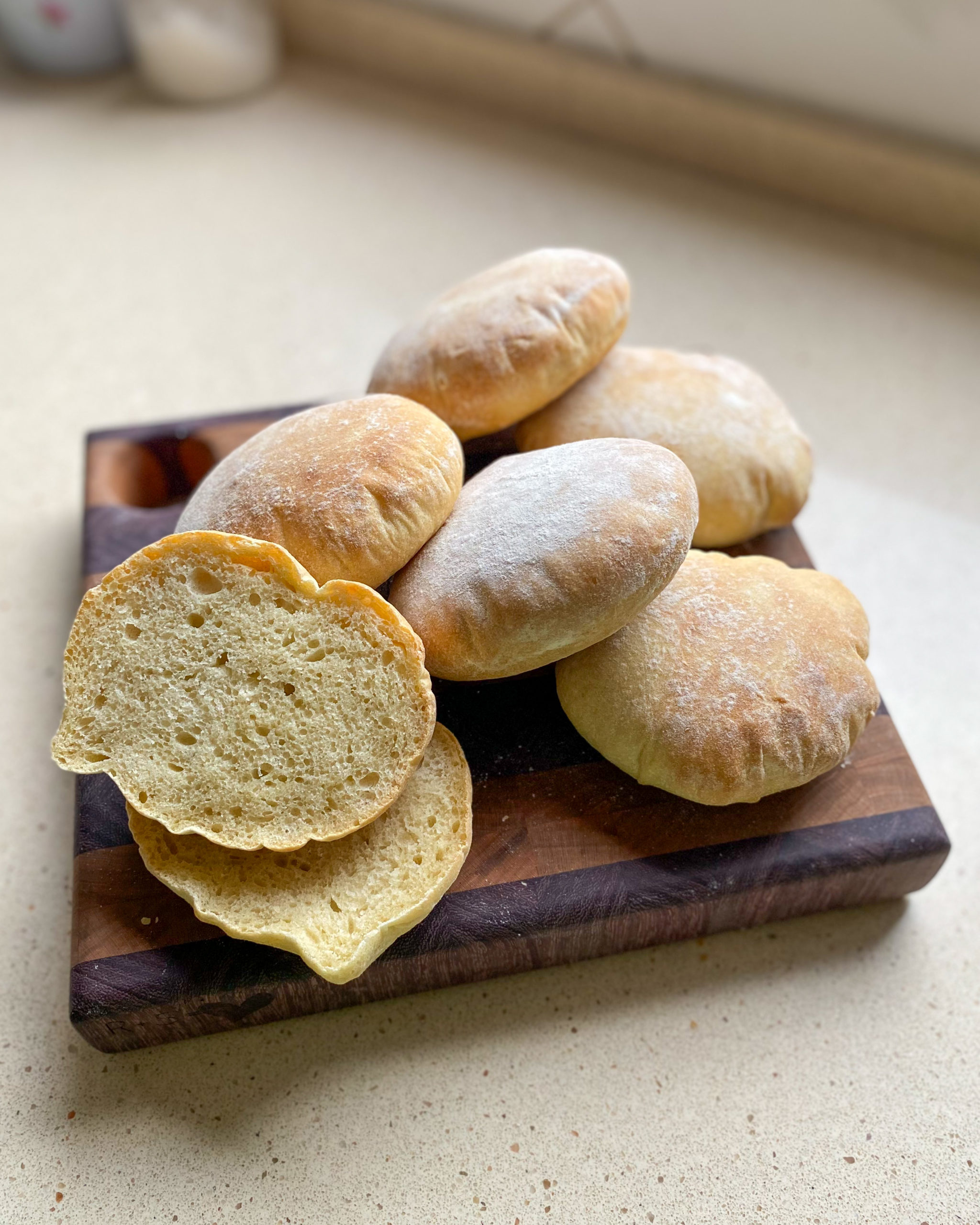These delicious and fluffy Spanish-style Molletes are fermented with a hybrid of sourdough starter and fresh yeast for a soft texture, yet quick process.
The Spanish word mollete (pronounced moy-eh-teh), originating from the word muelle, means springy or bouncy and actually covers a wide range of pillowy bread throughout Spain and Latin America. But, I’m focusing on the mollete de Antequera, which is actually under the Denominación de Origen Protegida (DOP), meaning it is a protected denomination of origin.
Having lived in Andalucía, Spain for some time now, I have had my fair share of molletes and I’m excited to finally get the recipe just right!
What Is a Mollete in Spain?
The Spanish mollete is a light round bun with a fluffy texture that doesn’t use milk or butter, but rather oil to achieve its characteristic soft crumb.
Anyone in Andalucía will tell you they are typically eaten for breakfast, generously topped with vibrant extra virgin olive oil, bright red tomatoes, and thinly-sliced Jamón Iberico. However, I’ve also seen my fair share of them in montaditos, which are small sandwiches eaten as tapas at bars.
They are also wonderful for topping with Andalusian Salmorejo, or you can use day-old molletes as a thickening agent to make homemade salmorejo.
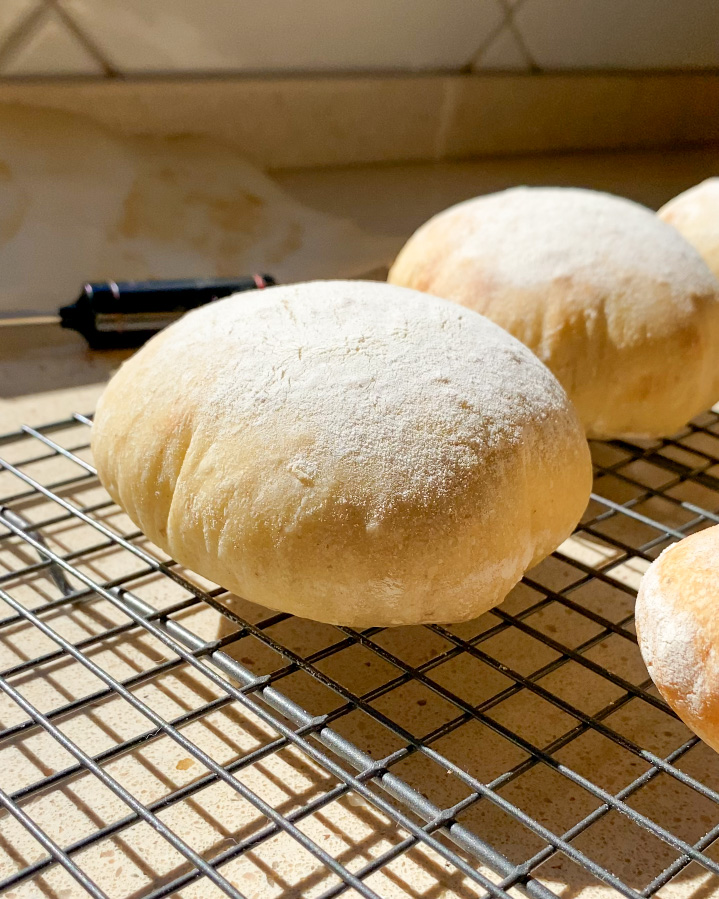
Ingredients to Prepare Molletes
To prepare molletes at home, you’ll need the following ingredients:
- Bread flour (protein 10-11%): For this recipe, you’ll need bread flour that has a protein content of about 10-11% because it favors a more delicate, tender crumb and softer crust. Tip: If you live in Spain, you can also use harina panadera.
- Finely ground durum wheat flour, semolina, or semolina rimacinata: This helps to add flavor to the dough, you can leave it out if need be. Tip: if you live in Spain you can find this as trigo duro or some millers sell semolina rimacinata.
- Extra Virgin Olive Oil: I almost exclusively use high-quality extra virgin olive oil in my recipes as I live in Spain and it is easy to find here, but you can also swap in another oil of choice.
- Sourdough starter: I prefer to use active sourdough starter in a levain, but you can also use sourdough discard from within the week (If it is very liquidy and inactive it might not do much for your dough).
- Fresh yeast: I prefer fresh yeast in bread recipes, but you can use dried here as well (sub in 1.5 grams/1/4 tsp of dry yeast).
- Water: Whatever water you would have no problem drinking, whether it be from the faucet/sink, filtered, or bottled.
- Salt: Any finer grain salt will be fine to more easily mix in (don’t use coarse salt).
Why Do You Use Olive Oil in the Recipe?
Oil is used to give the dough a soft crumb. When part of the hydration level (water) is substituted with a bit of dietary fats like oil, it helps to make the crumb softer. That, in combination with a flour that is lower in protein, helps to create the ideal soft texture we are looking for in a Spanish mollete de Antequera.
Why Does the Recipe Use Yeast Instead of 100% Sourdough?
When it comes to really light and soft bread, I often prefer the added benefits of using fermented sourdough starter with fresh yeast. It’s also nice that the yeast makes it a same-day process that takes a lot less time to ferment and proof. Using sourdough helps to give the dough some substance and I usually feel fuller longer, and the yeast helps to quicken the fermentation process making for a slightly more airy crumb.
However, you can choose to take out the sourdough starter or take out the yeast. If you do take the yeast out, know that the sourdough starter will need to be very active and it will take a while longer to reach the same result. I might even suggest a cold overnight proof of the dough.
If you’re looking for authentic sourdough bread, try out my go-to sourdough bread recipe.
Shaping Mollete Dough
There are two steps to shaping the dough. Once it has fermented, you will need to shape the dough into round balls on a covered floured surface to rest like in the first image, and then finally you’ll need to give them the classic flatter, yet still round shape and place on parchment paper to proof like in the second photo.
They will puff up quite a lot in the preheated oven, so it is essential to have a hot baking surface such as a baking stone or a preheated oven sheet, as well as added steam to give the dough a bit of added hydration to keep expanding.
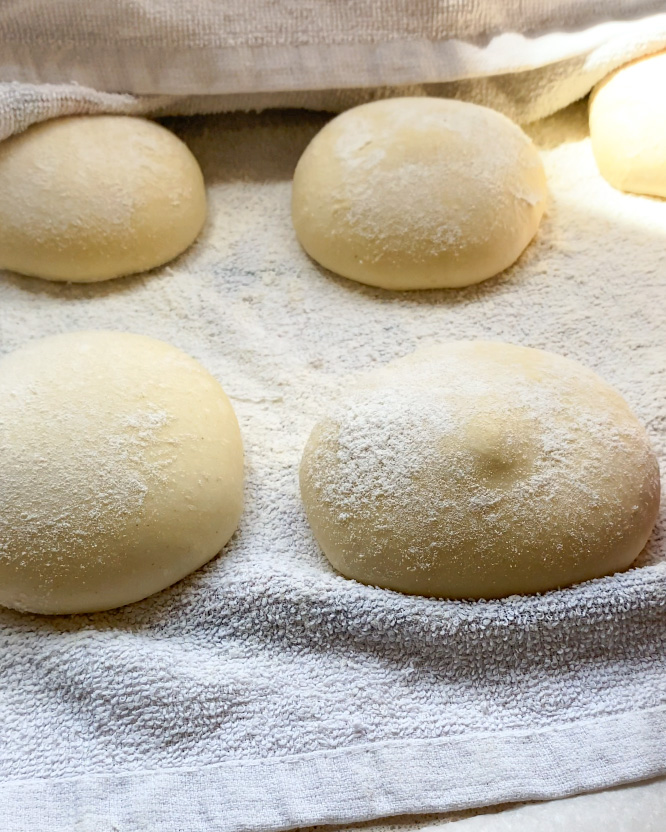
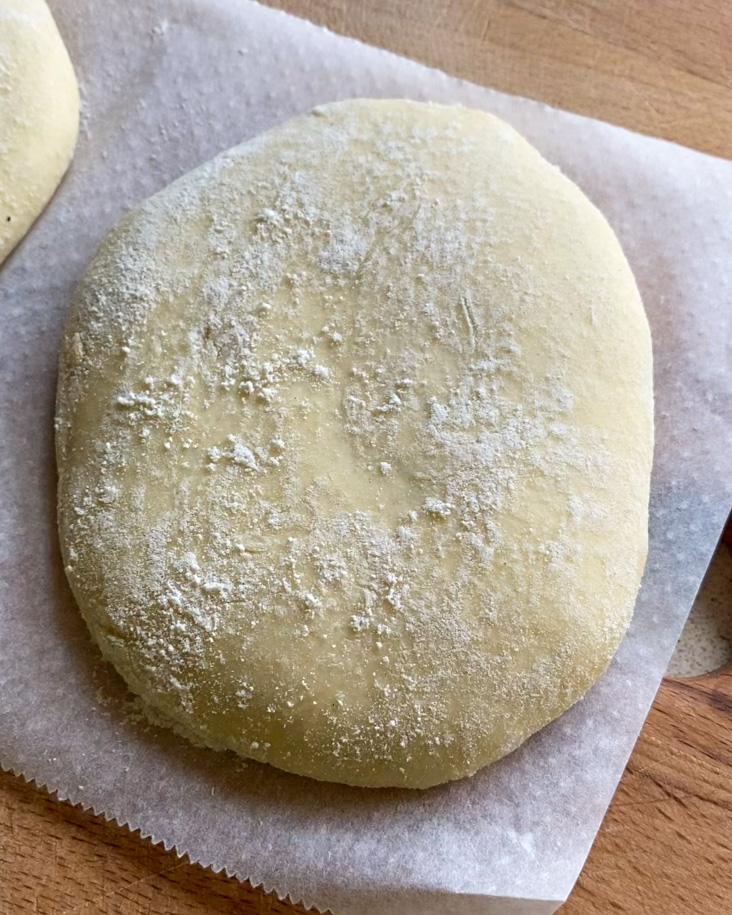
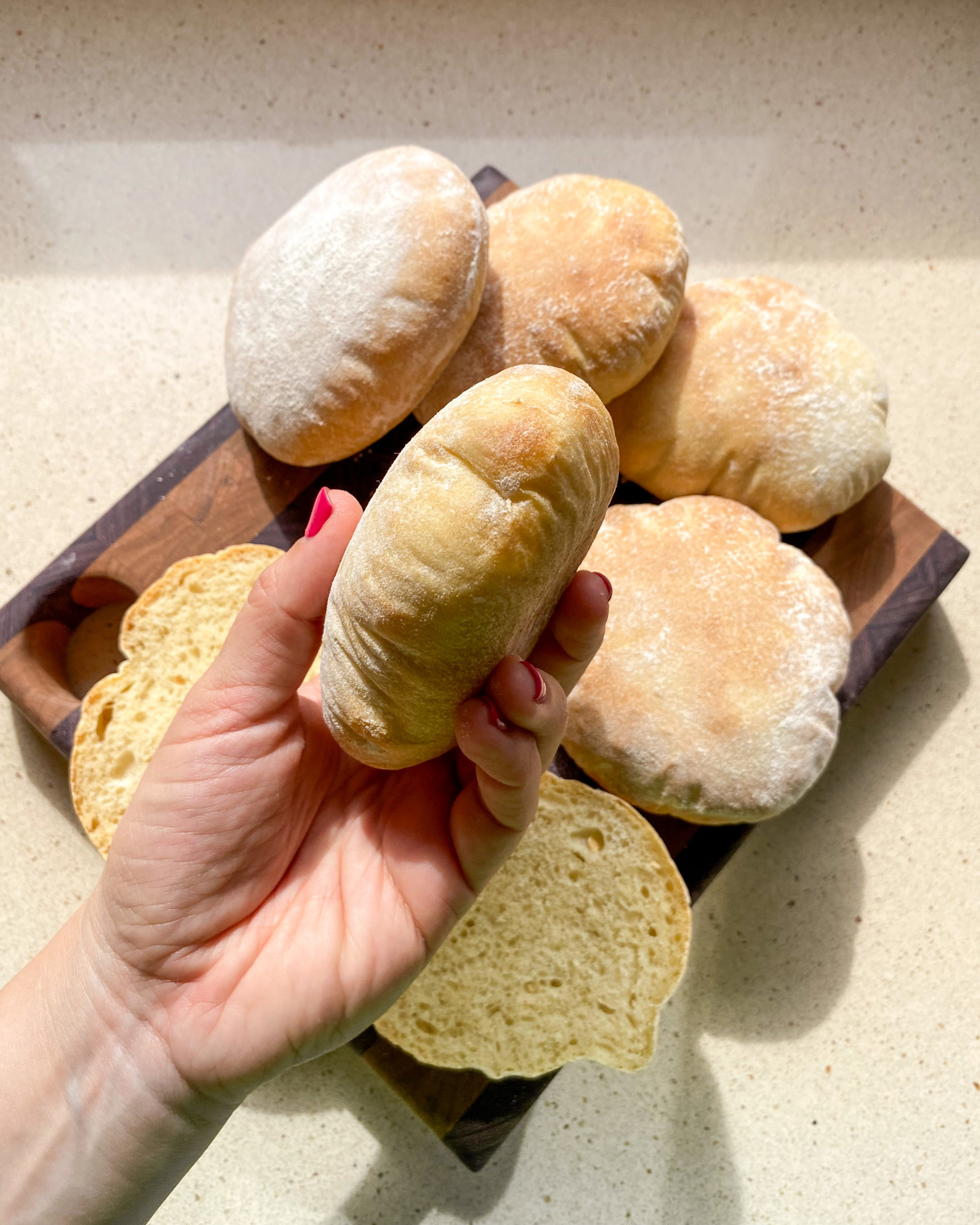
Recipe Method
Total dough yield: 727 grams
Levain percentage in the dough (inoculation): 30%
Total Hydration: (This includes the hydration from the levain) 61.7%
Tools You’ll Need For This Recipe
-Kitchen scale
-A dough scraper
-Large bowl
-Baking stone
Spanish-style Molletes with Sourdough and Yeast
Ingredients
For the Levain
- 25 g sourdough starter
- 50 g medium protein bread flour (10-11g protein)
- 50 g water
For the Bread
- 300 g medium protein bread flour (10-11g protein)
- 75 g Finely ground durum wheat flour, semolina flour, or semolina rimacinata
- 210 g Water
- 19 g Extra virgin olive oil
- 112 g Sourdough levain
- 8 g Salt
- 3 g Fresh yeast dissolved in 1 tsp water
Instructions
- Prepare the levain: Mix 50g flour, 50g water, and 25g starter in a straight sided cup or container to track it’s rise. Cover lightly and let sit in a warm place (about 25C/77F) until it has reached or almost reached double in size, about 4-6 hours.
- Autolyse: In a large bowl, mix the water and oil, then add in both flours. Mix well until no more bits of dry flour remain. Cover lightly with a damp towel and let that sit for about an hour. (I usually mix by hand, but you can also use a stand mixer to make the process easier.)
- Add Levain: Once the levain is light, bubbly, and near double in size it is ready to use. Pour the levain on top of your dough and mix it into the dough. Once the starter is incorporated, cover and let the dough sit for 10 minutes.
- Add salt and yeast: Pour the salt on top of the dough, and then pour in the yeast that has been dissolved in about 1 tsp of water. Mix both into the dough. It is normal if the dough does not remain a ball, continue to mix until everything is incorporated and the dough returns to a smooth ball shape. Cover the bowl, or you can move the dough into a greased straight-sided container to track its growth.
- Bulk fermentation: Let the dough sit for about an hour in a warm place (about 25C/77F). The fresh yeast will help it to ferment quickly in about 1 hour. If you are tracking the rise in dough, it should reach 50% it’s size or even 75% its size. If it reaches double its size that’s not a problem, however if it does not reach half its size in that time, let it sit in a warmer place for another 15 minutes and check it again.
- Pre-shape: Once the dough has fermented, pour it out onto a lightly floured surface. Using a kitchen scale and bench scraper or sharp spatula, measure out 6 individual pieces (about 120g each), or 8 (about 90g each). Shape them into balls and let them rest on a floured surface. Cover lightly with a towel and let sit for 30 minutes.
- Shape: Before shaping, prepare a piece of parchment paper that will fit a baking sheet or will fit your baking stone/steel. Gently move each mollete ball and flatten it lightly without knocking out all of the air. Place it on the parchment paper and continue for all 6 balls. Cover with a dry towel and let ferment for about 30-40 minutes in a warm place (about 25C/77F). The dough is ready to bake when they are light and fluffy and have grown slightly.
- Preheat the oven: While the dough proofs, preheat the oven above and below to 220C/425F with the baking stone or baking sheet placed inside on the middle rack, for at least 30 minutes. We also need to add in steam to the oven; I usually place a small oven proof baking pan on the buttom of the oven to preheat with the baking stone.
- Bake: When the dough is ready to bake, carefully move the parchment paper directly onto the baking stone or baking sheet, quickly pour water into the oven-proof pan on the bottom of the oven, and change the heat source to BELOW only. Bake for 10 minutes. After 10-12 minutes, carefully remove the pan with water, and continue to bake 3-4 more minutes with the heat source above and below. The idea is to continue cooking without browning too much to have the classic white mollete color. They are done cooking when the internal temperature reaches 90C/190F. Remove from the oven, and let cool on a wire rack at least 30 minutes before cutting.

